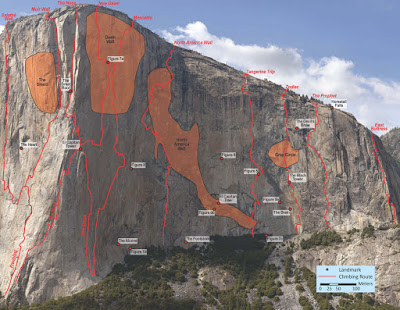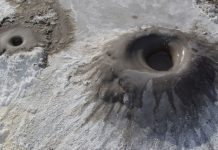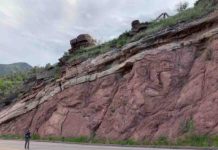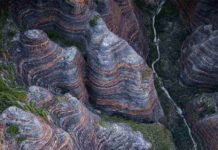
Granitic rocks make up much of Earth’s continental crust and many of the planet’s most iconic landscapes. However, granite’s formation is poorly understood because it happens tens of kilometers below the surface. In this unique study, authors Roger Putnam and colleagues combine decimeter-scale field mapping, rock climbing, and new dating and geochemical analyses to evaluate the timing and intrusive dynamics of the granitic rocks that make up El Capitan in Yosemite National Park, California, USA.
The comparatively accessible southeast face of El Capitan provides a clean, ~1-km-tall exposure of the interior of a granitic system. Putnam and colleagues found this vertical landscape to be a perfect place to test hypotheses regarding the formation of granitic rocks. In their paper published in Geosphere on 1 July 2015, the authors use climbing route designations as landmarks in describing the geology, along with both official and unofficial (e.g., North America; The Alcove) local place names.
They write that many models of granite formation rely on processes such as crystal/liquid segregation that should present a signature visible in the vertical dimension of a granitic system. They found that El Capitan is made up of seven different granitic units that episodically intruded over about three million years. Their chemical and textural analyses of samples collected along vertical transects of the two dominant rocks there, the El Capitan and Taft Granites, reveal no systematic patterns in rock composition. In fact, they conclude, “These data reveal [3 million years of] assembly of the plutonic system and show no evidence for gravity-driven separation of crystals and liquid over the 1 km vertical extent of the cliff,” which, they write, is “hard to reconcile with models of granite formation that envision magma chambers as large, mostly liquid, fractionating bodies.”
Reference:
Plutonism in three dimensions: Field and geochemical relations on the southeast face of El Capitan, Yosemite National Park, California
Roger Putnam et al., University of North Carolina, Chapel Hill, North Carolina, USA. Published online on 1 July 2015; DOI: 10.1130/GES01133.1.
Note: The above post is reprinted from materials provided by Geological Society of America.










